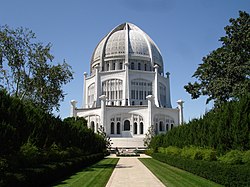Nettie Tobin: Difference between revisions
Header; removed already-linked see also |
m bolded article subject |
||
| Line 1: | Line 1: | ||
[[Image:Willmette how.jpg|thumb|250px|right|Bahá'í House of Worship, [[Wilmette, Illinois]].]] |
[[Image:Willmette how.jpg|thumb|250px|right|Bahá'í House of Worship, [[Wilmette, Illinois]].]] |
||
Esther Tobin (1863–1944), known as Nettie, was a widow and mother of two who worked as a seamstress in Chicago around the turn of the 20th century and became a member of the Bahá'í Community there. Tobin, who wished to contribute to the [[Bahá'í Temple Unity]] for the construction of the future [[Bahá'í House of Worship (Wilmette, Illinois)|Bahá'í House of Worship]] in [[Wilmette, Illinois|Wilmette]], [[Illinois]] was not able to contribute monetarily. Inspired by a letter that suggested even a "stone" to be a value, she went to a construction site nearby her home in [[Chicago]] and asked for a stone from the reject pile. With the help of friends and neighbors she was able to move the stone via streetcar and wagon to Wilmette, where it was left on the Bahá'í property. Although other stones had been sent for the dedication ceremony for the in 1912, none of them had arrived. On May 1, 1912,[[`Abdu'l-Bahá]] directed that "Nettie's stone" used as the dedication store of the future Bahá'í House of Worship. The "cornerstone" was not used in the construction of the building, but instead is displayed in the visitor's center, where it remains today. |
'''Esther "Nettie" Tobin''' (1863–1944), known as Nettie, was a widow and mother of two who worked as a seamstress in Chicago around the turn of the 20th century and became a member of the Bahá'í Community there. Tobin, who wished to contribute to the [[Bahá'í Temple Unity]] for the construction of the future [[Bahá'í House of Worship (Wilmette, Illinois)|Bahá'í House of Worship]] in [[Wilmette, Illinois|Wilmette]], [[Illinois]] was not able to contribute monetarily. Inspired by a letter that suggested even a "stone" to be a value, she went to a construction site nearby her home in [[Chicago]] and asked for a stone from the reject pile. With the help of friends and neighbors she was able to move the stone via streetcar and wagon to Wilmette, where it was left on the Bahá'í property. Although other stones had been sent for the dedication ceremony for the in 1912, none of them had arrived. On May 1, 1912,[[`Abdu'l-Bahá]] directed that "Nettie's stone" used as the dedication store of the future Bahá'í House of Worship. The "cornerstone" was not used in the construction of the building, but instead is displayed in the visitor's center, where it remains today. |
||
<br clear=all> |
<br clear=all> |
||
Revision as of 15:40, 22 June 2014

Esther "Nettie" Tobin (1863–1944), known as Nettie, was a widow and mother of two who worked as a seamstress in Chicago around the turn of the 20th century and became a member of the Bahá'í Community there. Tobin, who wished to contribute to the Bahá'í Temple Unity for the construction of the future Bahá'í House of Worship in Wilmette, Illinois was not able to contribute monetarily. Inspired by a letter that suggested even a "stone" to be a value, she went to a construction site nearby her home in Chicago and asked for a stone from the reject pile. With the help of friends and neighbors she was able to move the stone via streetcar and wagon to Wilmette, where it was left on the Bahá'í property. Although other stones had been sent for the dedication ceremony for the in 1912, none of them had arrived. On May 1, 1912,`Abdu'l-Bahá directed that "Nettie's stone" used as the dedication store of the future Bahá'í House of Worship. The "cornerstone" was not used in the construction of the building, but instead is displayed in the visitor's center, where it remains today.
See also
External links
